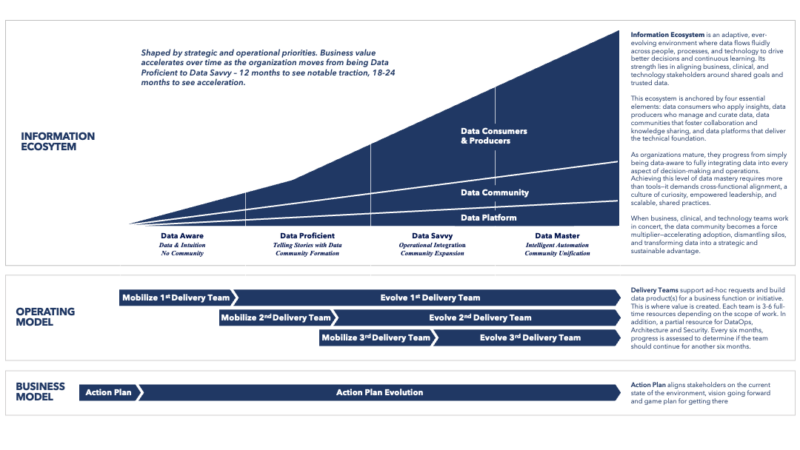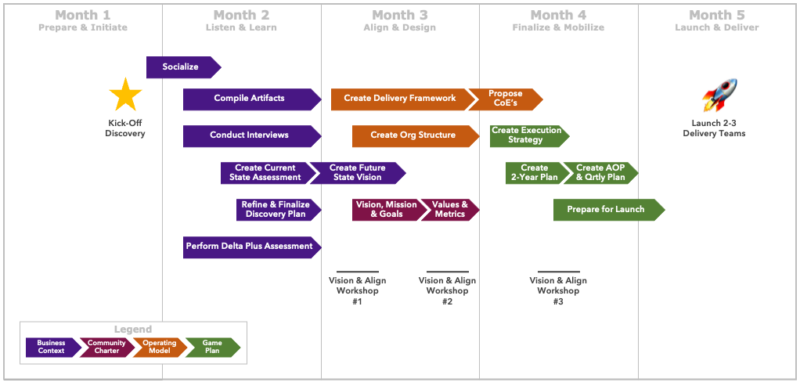
Frame and accelerate your journey to data mastery, or struggle and fail to succeed.
The speed and success of your journey toward data mastery hinges on how well you frame that journey, working with the community. Most of us know this instinctively — and likely agree. As it tends to be the case, the best reinforcement is a life experience outside the office, often from unexpected places. For me, it was my experience coaching Little League Baseball.
I never thought I would coach Little League. After watching and listening to my father’s experiences, this was the last thing I wanted to do. I just enjoyed watching practices and games while I sipped my latte. I found the experience relaxing, and it gave me a chance to have a shared experience with my boys. That changed the first year of coach-pitch baseball for 9-year-old players.
Coach pitch is an exciting time for the players because they no longer hit off a baseball tee. They get to swing at live pitching from the coaches. It is also a time when they begin to demonstrate an understanding of the rules, the ability to play different positions, and the ability to work together as a team. It is also a time when things get more competitive.
Even though the focus was on improving knowledge, skills and sportsmanship, and no score was officially kept, the players kept track — as did some of the parents — and they didn’t like losing all their games. Add to this that parents were frustrated because they didn’t see their kids developing, and by mid-season, tensions were rising among players, parents, and coaches alike.
It was around this time that I decided to leave a game early and wait in the car. There was so much complaining that it was no fun and a bit toxic. About 20 minutes later, my wife returned to the car with several burlap sacks of baseball gear and informed me that I was the new coach. Yikes! I knew nothing about coaching kids or teaching baseball. After quiet deliberation, I decided to give it a go.
The second half of the year was slightly better than the first half. That said, no matter how hard we tried, we could not get things back on track. The rest of the season was spent reacting to situations as they came up and making the best of a bad situation. No one even wanted to have an end-of-year celebration party. I felt bad for the kids, parents and coaches — not to mention my kiddo.
Upon reflection, it wasn’t the coaches’ ability to teach the players or the motivation of the players and parents that created the poor experience and outcome. Clearly, the players, parents and coaches were not aligned on the goals for the season and the rules of engagement, and they were not working together as a team to create a great experience.
So, the following year, I decided to give it another go. The team name was Ogden Raptors — named after a minor league team for the Milwaukee Brewers. This was the first year players pitched, making the experience feel more like big league play. The difference is that baselines are much shorter, and players can’t lead off. It was a very exciting time for the kids. It is also a time of much more complexity and opportunity for drama.
Before players picked up a ball or bat, we all came together over snacks on a Saturday afternoon to align on what we wanted out of the season. This discussion was framed with a handout I provided at the start of the meeting. We took time to get to know each other, discuss goals for the season, expectations of the players, parents and coaches, and how we would work together. It was a lively and upbeat discussion, and in a short time, we aligned and ended the day on a very positive note.
The following practices went great. There was a lot of involvement and support from parents, and the players were having an enjoyable time. Then came our first game. It was wet and very cold, as it often gets in April in the Northwest.
After all the practices and preparation, the team was beaten down badly by a team that went onto win every game that season — the AquaSox. They had some incredible players, including an amazing pitcher for his age. I was tempted several times to ask for his birth certificate. Then again, this was just sour grapes. At some level, I knew I had been outcoached.
After the game, we talked about how we aren’t defined by events but by how we respond. We discussed how playing baseball is about learning how to deal with failure and learn from the experience. The best professional ballplayers, after all, strike out seven out of every ten at-bats.
We also talked about what we learned from the experience and what we can do to improve. Given that the parents were part of the team, they were also there to listen in on the discussion. On that Saturday afternoon to align on the season, this is part of how we decided to work together.
By the next practice, the players were energized and more focused than ever. Over the remainder of the season, they continued to improve with their parents’ help and did well enough to make it to the championship game. And wouldn’t you know it, they ended up playing the team that beat them in the first game of the year: the undefeated AquaSox.
Before the game, we all agreed to focus on playing our best game. We knew they had an incredibly strong pitcher, so we talked about strategy and how we could best match up in batting, base running, etc.
When gameday came, the team felt prepared. It was a very exciting and emotional game, with parents and grandparents screaming at players, coaches and umpires (but not our players and families). At one point, the umpire had to throw out a parent from a 9-year-old baseball game.
By the end of the game, the kids played their best game that season to beat the AquaSox and win the championship. We even had a big party later that day. It turned out to be an excellent experience for everyone that day and throughout the season.
That season was a turning point for me, not just in coaching but also in understanding the power of framing a journey. Success wasn't about talent or individuals alone; it was about having a common vision, clear expectations, a shared plan, and working together as a team or community.
Whether coaching Little League or implementing a data strategy, the same principle applies: frame your journey or struggle and fail to succeed. In the next section, I’ll share a practical framework you can use to frame your data fluency journey in just 90 days, helping your team play their best and win its own championship.

Frame It to Win It - Action Plan Template
Download this action plan template to plot out your 90-day roadmap and structure your business context, charter, operating model, and delivery plan.
Framing Your Journey
Framing is about aligning the community around a shared understanding of the destination and the path to get there, creating clarity, alignment, and efficiency before embarking on the data mastery journey. Your focus in framing the journey is to develop the data strategy and establish the foundational work needed to operationalize it.
The key deliverable is an action plan, a strategic guide designed to align the community around the current state of the environment, the future vision going forward, and a game plan for getting there. When done right, the action plan creation aligns the community and fosters shared ownership, as the community can see their fingerprints all over the document.
A core principle of this approach is to do just enough to get started and evolve the action plan based on changes to the business landscape and lessons learned. Another core principle is to frame a journey that delivers early, iteratively, and often, demonstrating value along the way.
Below is an illustration of how the action plan creates the spark that ignites and shapes the evolution of the information ecosystem. In a sense, it is akin to the Big Bang.

Action Plan Framework
The action plan comprises four integrated components, each building upon the next to form a cohesive strategy and execution plan, as illustrated below.

Business Context
Establishes a shared understanding of the current environment and aspirational future state. This deliverable aligns the community on where they are, where they are going, and the foundational work needed to get there.
Deliverables include an assessment of the current state and a vision for the future state. Your diagnosis should cover analytics and AI use cases and capabilities, data governance, and state of your data platform. Additionally, a gap analysis is created that informs the game plan.
The IIA Delta Plus framework is a very useful tool for this body of work. It can provide objective input on the current and future state, inform the two-year roadmap, and provide an annual assessment of progress.
Community Charter
The charter uses the business context to define an aspirational and compelling reason for the data community's existence that transcends organizational boundaries. It articulates the community’s identity, purpose, and the outcomes it seeks to achieve, including how success will be measured.
The charter helps unify and energize the data community and foster cross-functional collaboration.
Operating Model
Describes how the data community—comprising data consumers, producers and operations (ops) —will work together and partner to deliver value. This includes the delivery approach, organizational structure, initial delivery teams, and so on. This will align and augment existing practices to the fullest extent possible.
This is usually the most challenging component of the action plan to get alignment in the community. There are always multiple ways that work gets done, and the goal is to align the community on a single operating model. This often involves a lot of change in areas where people are heavily invested.
I have successfully used a version of a federated operating model to introduce a new way of working. This approach is well-suited to being rolled out incrementally to willing participants and evolving over time as it is proven and others want to try it out. Check out “Operating Like a Start Up” and “Thinking Like an Entrepreneur” for more of my thinking and first-hand experience with the federated approach.
Game Plan
Brings together all elements of the action plan to provide strategic and tactical execution roadmaps. It includes:
- A high-level five-year strategy
- A two-year roadmap that aligns with the Annual Operating Plan (AOP)
- Cost estimates (labor and non-labor) that support the two-year roadmap
- First quarterly plan and training on quarterly planning practices – using the Objective and Key Results (OKR) framework.
Action Plan Evolution
The action plan development and preparation for launching the initial delivery teams are designed to take place over 90 days. While the duration may vary slightly based on organizational complexity and resource availability, maintaining momentum is critical. Delays beyond this window risk losing stakeholder engagement and organizational focus.
Below is an illustration of how the creation of the action plan evolves over 90 days. This is the “happy path.” Reality often differs as the first 30 days unfold. So, adapt accordingly with a laser focus on completing this journey within 90 days.

First 30 Days: Listen and Learn
The focus is on engaging stakeholders and building a clear picture of the current state (data consumers, analytics capabilities, data content, data governance and data platform) while beginning to surface future needs and opportunities. Insights are gathered through a combination of artifact review and stakeholder conversations.
In addition, an assessment is conducted using an industry-accepted framework: IIA Delta Plus. During this phase, initial community charter and operating model drafts are created to begin framing the path forward.
Days 30–60: Align and Design
Finalize the business context, community charter and operating model, aligning stakeholders around shared purpose, roles, and working methods. To facilitate this, it is best to conduct a series of in-person vision and alignment workshops to gather input and promote alignment with key stakeholders, including a cross-section of leaders and frontline contributors.
The IIA Delta Plus assessment findings will also help shape the understanding of the current state and create a two-year roadmap.
Days 60–90: Plan and Mobilize
Finalize the game plan and complete preparations to launch the first two to three delivery teams, positioning the organization to move from planning to execution and deliver early, visible impact. This will include developing an execution strategy, a two-year plan that aligns with the Annual Operating Plan (AOP), and a quarterly roadmap used to mobilize the delivery teams.
Action Plan Deliverables
Here is a list of key deliverables that make up the action plan.
1. IIA Delta Plus Report
Output of the Delta Plus assessment. Serves as a foundational input for the current and future state analysis.
2. Current State, Future State, and Gap Analysis
Evaluation of analytics and AI maturity and future state across analytics and AI competency (data, capabilities and people), data governance, and data platform. Identifies key gaps and opportunities.
3. Data Platform Assessment
Focuses on infrastructure, architecture, and tools that support data ingestion, integration, storage, access, and analytics. This includes evaluating data architecture, integration of third-party analytics, performance, scalability, cloud adoption, interoperability, security, operations, and support for advanced analytics and AI workloads. The analysis will surface gaps in current platform capabilities relative to organizational goals and identify opportunities for modernization or optimization to enable a more agile, governed, innovative, and impactful use of data.
4. Community Charter
Defines the vision, mission, goals, metrics, and values that will energize and guide the data community.
5. Operating Model
Review, revise and align on the delivery framework, organization structure, and initial delivery teams while leveraging existing practices.
6. Delivery Team Mobilization Plan
A detailed plan to prepare and launch initial delivery teams aligned to strategic and operational focus areas. This will include training on the operating model and data fluency.
7. Five-Year Strategy
A strategy staircase outlining the evolution of the information ecosystem over five years, mapped to strategic business priorities.
8. Two-Year Roadmap
Major initiatives are organized by analytics competency, data governance, and data platform domains.
9. First Quarterly Plan
Developed by delivery teams, this plan will include OKRs and support training on the quarterly planning process.
10. Final Action Plan
A synthesized, executive-ready document that will evolve over time. It includes an executive summary covering business context, charter, operating model, and game plan, with references to supporting materials.
Action Plan Commitment
As we’ve discussed, active and consistent engagement from the data community is essential to action plan development and the ability to transition from framing to launching the journey. Below are the estimated time commitments for each resource group to complete the action plan.

The estimates are presented as a range (minimum and maximum) to account for variability in engagement, which may differ depending on organizational readiness, stakeholder availability, and the complexity of the analytics strategy.
Each resource group’s time investment is critical in the successful development and execution of the action plan. Clearly defining and estimating the required effort ensures that all stakeholders have a shared understanding of their roles and responsibilities, leaving their mark on the action plan.
Final Thoughts
The difference between floundering and flourishing often comes down to how well you frame the journey before taking the first step. It’s not about having all the answers — it’s about having shared direction, clear expectations, and the structure to learn and adapt together.
Framing gives the data community a voice in the plan and a stake in the outcome. It turns strategy from a top-down directive into a shared commitment. That’s where momentum comes from — not from perfect planning, but from people believing in the mission and knowing how to contribute.
Yes, you could skip the framing, move fast, and launch early. But that usually means circling back later to clean up confusion, rebuild trust, and realign on goals.
So, start with clarity and invest the time to frame it right – it only takes 90 days. Do just enough to move forward with confidence. And bring your community along for the ride, because when they own the journey, they’ll power the outcome.
Given that this piece started with sports, it would be appropriate to end with a powerful quote from Ted Lasso that has stuck with me, as it rings true whether coaching baseball or leading a data community.
It was a discussion Ted had with Trent Crimm, The Independent. When asked about winning, he said: “For me, success is not about the wins and losses. It’s about helping these young fellas be the best versions of themselves on and off the field.” If you can do this with your data community, you will accelerate your journey to data mastery.
Contact us if you are interested in a free 30-consultation with IIA Expert Ryan Sousa to discuss your data mastery journey and action plan, where he will share a PowerPoint template and other resources.